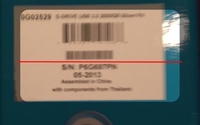Commentary
In-Store Barcode Scanning & the Reverse Price Match
- by Chuck Martin , Staff Writer, August 2, 2013
 Mobile barcode scanning can lead to more than websites and
rich experiences.
Mobile barcode scanning can lead to more than websites and
rich experiences.
I was reminded of this earlier this week when one of my sons returned from Best Buy with a new, high-performance multi-terabyte hard drive (he’s a videographer and deals with large video files) for his computer.
He proudly informed me he got a deal after scanning the barcode. As you might expect, he has grown up with barcode scanning as a routine part of his in-store shopping behavior.
Unlike many, he never had a BlackBerry but started with Android. Over the years, he has joined me in retail store visits to monitor various shopping behaviors and test new scanning apps in trials.
But this time his scanning experience was different.
Rather than scanning a barcode to see who had the best price so he could have Best Buy match it, he had what he called a “reverse price matching” experience.
His ShopSavvy barcode scan showed that not only was the price listed on the hard drive lower than anywhere else, it was even lower than the price Best Buy was listed in the app as selling it for, both in-store and online.
Rather than a price match from digital information, he identified that the physical price on the physical product was lower than any other price, including online-only seller prices.
He concluded from the specs that the price had been increased digitally and online but not yet at the physical shelf. He quickly bought it at the lower price.
This scanning experience is just one example of the power of mobile in the path to purchase.
It’s not just about scanning a barcode to get a price match; it’s really about being totally informed in real time to assure the consumer is receive the best value.
The shopper may decide to make a purchase at the moment, ask a retailer to match a competitor’s price, purchase at another store or buy online. But the entire decision process is controlled by the consumer.
Barcode scanning is yet one more access point to quick knowledge and insight.
We know from a recent Deloitte study that two-thirds (66%) of shoppers plan to use their smartphones to get price information while a majority (60%) plan to find discounts, coupons or sale information.
Mobile shoppers are looking for an advantage. Deloitte found that competitive pricing remains the top mobile incentive. But it’s more than that.
Mobile shoppers are receiving information and empowerment.




Another in store scanning app that works in any store is Swift Shopper. Swift shopper allows customers to scan items as they put them in their carts. At checkout they present their phone and the cashier scans the bar codes right of the phone. Saves up to 75% time at checkout. Swift Shopper is free to stores and free to shoppers. You can checkout at stores that have 2D hand scanners. It requires no integration. Stores like Lowes, Target, Walgreens, Kroger, BJ's, Total Wine etc... all have 2D hand scanners.
You don't give the name of the Deloitte survey, or link it. But I'm pretty sure it was the one I've linked below. If so, it seems the Deloitte survey question was not about shoppers, or barcodes, or anything in-store, but "Of those respondents planning to use Web-enabled smart phones to assist in their back-to-school shopping". Browsing the Web while sitting on the couch watching TV would have qualified and seems much the most likely scenario, especially as, despite the hype, I've still never seen anyone using their smartphone to scan barcodes in store. https://www.deloitte.com/assets/Dcom-UnitedStates/Local%20Assets/Documents/RetailDistribution/us_retail_backtoschoolandcollege_073013.pdf
The point was that consumers/shoppers are looking for an advantage, as this study and numerous others have stated. People are using smartphones to scan in store.(the old saying: "just because you don't see it doesn't mean it isn't happening") Thanks for adding the link, appreciated.